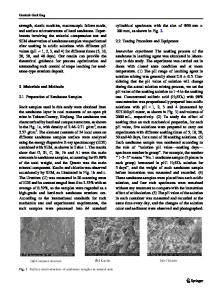Effect of pH on the electrochemical properties of polyaniline nanoparticle suspension in strongly acidic solution: an ex
- PDF / 1,312,853 Bytes
- 13 Pages / 595.276 x 790.866 pts Page_size
- 93 Downloads / 366 Views
ORIGINAL PAPER
Effect of pH on the electrochemical properties of polyaniline nanoparticle suspension in strongly acidic solution: an experimental and theoretical study Fatemeh Biabangard 1 & Hadiseh Nazari 1 & Reza Arefinia 1 Received: 14 August 2020 / Revised: 8 October 2020 / Accepted: 6 November 2020 # Springer-Verlag GmbH Germany, part of Springer Nature 2020
Abstract A stable suspension of nanopolyaniline (nPANI) particles can be used in various applications instead of a polyaniline film. The electrochemical behavior of a stable suspension of nPANI particles, in strongly acidic conditions of HCl at the gold electrode surface, was investigated using various electrochemical and surface analysis methods. Voltammetry results showed two redox transformations indicating the adsorption and diffusion-controlled mechanism of nPANI particles. Moreover, the decrease in pH causes an increase in the number of electrons transferred per nPANI particles. The adsorption data were fitted by the Langmuir adsorption isotherm and the maximum surface coverage decreases with the increment of pH. The adsorption of nPANI particles was confirmed by the surface analysis methods. Moreover, the quantum chemical calculation and Monte Carlo simulation approved the electrochemical results for the effect of pH on the adsorption of nPANI particles at the gold electrode surface. Keywords Nanopolyaniline particles . Redox behavior . Adsorption . Diffusion . Quantum chemical calculation
Introduction Polyaniline (PANI) is the most famous conducting polymer from both the fundamental and application viewpoints due to its unique properties such as easy synthesis, different oxidation states, good redox reversibility, electrical and optical properties, and reasonable price [1–3]. The redox behavior of PANI provides the great attention in many applications such as medical [4, 5], electrochemical sensors [6, 7], supercapacitors [8–10], rechargeable batteries [11, 12], anti-corrosion agents [13–15], and ion exchange [16, 17]. Generally, PANI can be obtained in three main oxidation states: leucoemeraldine (LE), its completely reduced form; emeraldine (EB), its half oxidized form; and pernigraniline (PE), its completely oxidized state [18, 19]. The EB form is nonconductive in its nature but it can be converted to the conductive form, namely emeraldine salt (ES), by protonating * Reza Arefinia [email protected] 1
Chemical Engineering Department, Faculty of Engineering, Ferdowsi University of Mashhad, Mashhad, Iran
in an acidic environment (doping process). The redox properties of PANI depend strongly on both its oxidation state and protonation level [20, 21]. On the other hand, many factors such as the potential range [20], solution pH [22–24], and temperature [25] affect the redox behavior of PANI. From the practical viewpoint, solution pH in different applications has a great influence on the properties of PANI. As an example, a new type of ion exchangers works on the basis of the doping/de-doping processes of PANI, depending on the pH of the solution
Data Loading...











